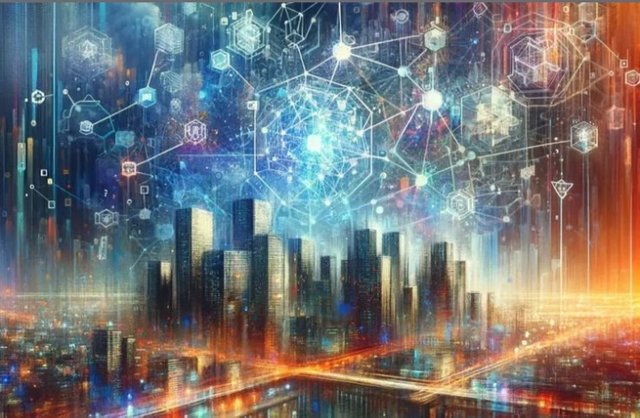What is RWA and How is it Used in Blockchain Technology?

RWA (Real-World Assets) and Blockchain: How Future Technology is Transforming the World
Blockchain technology plays a crucial role in the digital revolution. This technology ensures the secure, transparent, and immutable recording of data and transactions. However, one of the most exciting and groundbreaking innovations that blockchain offers is Real-World Assets (RWA), the digitization and tokenization of real-world assets. In this article, we will explore what RWA is, how it can change the world and our technology, and provide examples of the best DeFi projects and successful RWA implementations.
What is RWA?
Real-World Assets (RWA) refers to the representation of physical assets in the digital world. These assets can include real estate, artworks, commodities (like gold and silver), agricultural products, debt securities, and more. RWA occurs through the representation of these assets as digital tokens on the blockchain. These tokens represent the ownership and value of the physical assets.

How Can RWA Change the World and Technology?
Transparency and Security:
Blockchain technology offers an immutable ledger, making it impossible to alter or delete data. This ensures the transparent and secure tracking of the ownership and transaction history of tokenized assets. Everyone can verify these transactions on the blockchain, enhancing security and trust.Accessibility and Liquidity:
Traditional assets often require significant capital and have low liquidity. For instance, a building or a valuable artwork is typically accessible to only a few people. However, with RWA, these assets can be divided into smaller parts and presented as digital tokens. This provides access to a broader range of investors and makes the assets more liquid.Fast and Low-Cost Transactions:
In traditional financial systems, asset transfers can take weeks and incur high transaction costs. However, blockchain technology makes these transactions faster and cheaper. For example, real estate ownership can be transferred via blockchain within minutes.Financial Democracy:
RWA democratizes the financial system. Even small investors can access investments that require significant capital. This spreads financial opportunities to a broader audience and enhances economic equality.Integration with DeFi:
Decentralized Finance (DeFi) platforms facilitate lending and borrowing transactions using tokenized real-world assets as collateral. This makes financial services more democratic and creates more liquidity.
Best DeFi Projects and RWA Examples
MakerDAO:
MakerDAO is one of the leading projects in the DeFi world. This platform allows users to create a stablecoin called DAI. Users can generate DAI by using tokenized assets as collateral. This is a great example of how RWA can be used in lending and borrowing transactions.Aave:
Aave is a DeFi platform that facilitates lending and borrowing transactions. Users can borrow against various crypto assets used as collateral. Aave plans to accept tokenized real-world assets in the future, showing the integration of RWA and DeFi.RealT:
RealT is a platform that tokenizes real estate properties in the United States. Investors can buy tokenized shares of properties through the RealT platform. These tokens represent ownership rights on the blockchain and provide investors with regular rental income. RealT has achieved great success by making real estate investments more accessible and liquid.Centrifuge:
Centrifuge is a platform that helps businesses tokenize invoices and receivables to provide liquidity. Businesses can tokenize their invoices and receivables through the Centrifuge platform and sell them to investors. This provides quick financing for businesses and short-term investment opportunities for investors.Maecenas:
Maecenas is a platform focused on the tokenization of artworks. This platform offers artworks to investors through digital tokens. For example, shares of a famous painting can be tokenized and sold to thousands of investors. This democratizes art investments and provides investors access to valuable artworks.
Looking to the Future
The concept of Real-World Assets (RWA) is only the beginning of the transformative potential of blockchain technology. As we look ahead, the integration of RWA with blockchain will significantly alter our economic landscape and bring about revolutionary changes in several key areas:
Increased Financial Inclusion:
By tokenizing real-world assets, individuals from all over the world, regardless of their economic background, will have access to investment opportunities that were previously out of reach. Small investors can now own fractions of high-value assets such as real estate, art, and commodities, which were once reserved for the wealthy. This democratization of investment opportunities will bridge the gap between different economic classes and promote financial inclusion.Improved Efficiency in Asset Transactions:
Traditional asset transactions, such as buying and selling real estate, are often time-consuming and involve significant paperwork. Blockchain technology streamlines these processes, reducing the time and costs associated with asset transactions. Smart contracts can automate the execution of terms, ensuring quick and secure transfers of ownership. This enhanced efficiency can revolutionize industries that rely on frequent asset transactions, such as real estate, finance, and supply chain management.Enhanced Liquidity:
Tokenized assets can be traded on various decentralized exchanges, providing liquidity to markets that were previously illiquid. For example, selling a fraction of a property is much easier than selling the entire property. This increased liquidity allows investors to quickly convert their assets into cash or other investments, making markets more dynamic and responsive to economic changes.Strengthened Regulatory Compliance:
Blockchain's immutable ledger provides a transparent and traceable record of all transactions, which can help in regulatory compliance and reduce fraud. Regulatory bodies can use blockchain technology to monitor transactions in real-time, ensuring that all parties adhere to legal and financial regulations. This transparency can enhance trust in financial markets and reduce the risk of financial crimes.New Financial Products and Services:
The tokenization of real-world assets will lead to the creation of innovative financial products and services. For instance, fractional ownership can pave the way for new forms of insurance, lending, and investment products tailored to individual needs. Decentralized Finance (DeFi) platforms will continue to evolve, integrating RWAs to offer more diverse and sophisticated financial instruments.Empowerment of Small and Medium Enterprises (SMEs):
Small and medium enterprises often face challenges in accessing capital. By tokenizing their assets such as invoices, receivables, or even equipment, SMEs can unlock liquidity and access funding more easily. Platforms like Centrifuge are already paving the way for SMEs to leverage their assets for financing, fostering innovation and growth in this critical sector.Globalization of Markets:
RWA and blockchain can transcend geographical barriers, enabling a truly global market for assets. Investors from different parts of the world can participate in markets previously restricted by local regulations and logistical challenges. This globalization can lead to more efficient allocation of resources and greater economic integration across borders.Environmental and Social Impact:
Tokenizing real-world assets can also contribute to environmental and social goals. For example, carbon credits can be tokenized and traded on blockchain platforms, making it easier for companies to offset their carbon footprints. Similarly, tokenized impact investments can direct capital towards projects that promote social good, such as renewable energy initiatives or affordable housing developments.
Case Study: RealT and Real Estate Tokenization
RealT is an excellent example of how RWA is transforming traditional industries. By tokenizing real estate properties in the United States, RealT allows investors to purchase fractional ownership of properties. This model not only makes real estate investments more accessible but also provides investors with regular rental income and liquidity through secondary market trading. RealT's success demonstrates the potential of RWA to democratize investment and create new financial ecosystems.
Conclusion
The future of Real-World Assets (RWA) and blockchain is incredibly promising. By bridging the gap between the physical and digital worlds, RWA has the potential to transform our financial systems, making them more inclusive, efficient, and transparent. As we continue to explore the possibilities of this technology, we can expect to see a new era of innovation and growth in global markets. Embracing the potential of RWA and blockchain today will pave the way for a more equitable and prosperous future for all.
Lastly:
RWA stands for the concept of tokenizing real-world assets using blockchain technology, and it holds significant potential in the financial world. This approach, by digitizing assets, can revolutionize the financial system by providing increased accessibility, liquidity, and efficiency. Particularly when combined with DeFi projects, RWA has the potential to offer greater financial inclusion and innovative investment opportunities. However, there are also challenges and regulatory issues to navigate in the development and adoption of this field. Overall, I am excited about how RWA can reshape the financial world and am closely following developments in this area.
Let's discuss our opinions in the comments. Don't forget to like, and I'm waiting for your support.